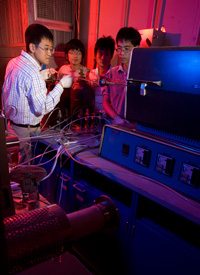The 2010 Nobel Prize in Physics went to the two scientists who first isolated graphene, one-atom-thick crystals of graphite. Now, an investigator with the University of Houston Cullen College of Engineering is finding success in his work to develop a method to mass-produce this revolutionary material.
Graphene has several properties that make it different from literally everything else on Earth: it is the first two-dimensional material ever developed; the world’s thinnest and strongest material; the best conductor of heat ever found; a far better conductor of electricity than copper; it is virtually transparent; and is so dense that no gas can pass through it. These properties make graphene a game changer for everything from energy storage devices to flat device displays.
Most important, perhaps, is graphene’s potential as a replacement for silicon in computer chips. The properties of graphene would enable the historical growth in computing power to continue for decades to come.
To realize these benefits, though, a way to create plentiful, defect-free graphene must be developed. Qingkai Yu, an assistant research professor with the college’s Department of Electrical and Computer Engineering and the university’s Center for Advanced Materials, is developing methods to mass-produce such high-quality graphene.
Yu is utilizing a well-established technology known as chemical vapor deposition (CVD). During this process he heats methane to around 1000 °C, breaking the gas down into its building blocks of carbon and hydrogen atoms. The carbon atoms then attach to a metallic surface to form graphene. “This approach could produce cheap, high-quality graphene on a large sale,” Yu said.
Yu first demonstrated the viability of CVD for graphene creation two years ago in a paper in Applied Physics Letters. Out of the more than 5,000 papers published in Applied Physics Letters since that time, Yu’s is the seventh most cited.
He has since continued working to perfect this method. Yu’s initial research, while clearly successful, would often result in several layers of graphene stacked together on a nickel surface. He subsequently discovered the effectiveness of copper for graphene creation. Like nickel, copper acts as a catalyst that encourages the breakdown of the methane, but it offers better control over the number of graphene layers that form. The end result is a single layer of graphene with few defects. Copper has since been adopted by graphene researchers worldwide.
Yu’s work is not finished, however. The single layers of graphene he is now able to create are formed out of multiple graphene crystals that join together as they grow. The places where these crystals combine, known as the grain boundaries, are defects that limit the usefulness of graphene in any number of applications, particularly as a replacement for silicon-based computer chips.
Yu, therefore, is now attempting to create large layers of graphene that form out of a single crystal. Since this research is ongoing, he is understandably unable to discuss the approach he is now using. His method of creating single-crystal graphene, however, shows much promise.
“You can imagine how important this sort of graphene is,” said Yu. “Semiconductors became a multibillion-dollar industry based on single-crystal silicon and graphene is called the post-silicon-era material. So single-crystal graphene is the Holy Grail for the next age of semiconductors.”
Yu is conducting this research in collaboration with University of Houston Ph.D. students Wei Wu and Zhihua Su as well as postdoctoral researcher Zhihong Liu. These efforts have been supported by SEMATECH and the UH Center for Advanced Materials.
